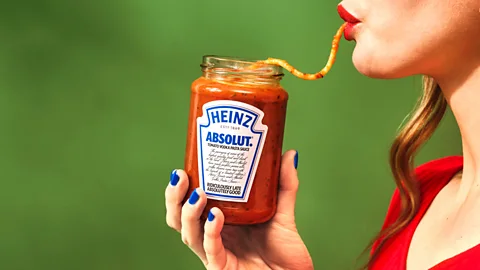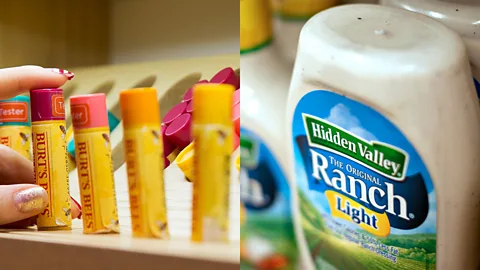The 'unhinged' product mash-ups that sell out in hours
 Courtesy of Kraft Heinz
Courtesy of Kraft HeinzBrands are collaborating on increasingly odd-couple products. They're flying off shelves.
In January, natural skincare brand Burt's Bees teamed up with Hidden Valley Ranch, the American company behind the wildly popular creamy, tangy salad dressing, to create a four-pack of lip balms. The marketing boasted the "craveable flavour of ranch and buffalo wings". Salad dressing-flavoured lip balm may not seem like the next must-have trend – yet the mash-up sold out in a matter of hours, thanks to savvy positioning and curious customers.
The cheeky collaboration is the latest in a years-long string of unexpected brand partnerships, from Velveeta-cheese-scented nail polish, to the Amsterdam Van Gogh Museum's 2023 collaboration with Pokémon. While the limited-run partnerships may not result in stunning profits, experts argue that they strike the perfect note with today's novelty-obsessed consumers, which makes them ultra-covetable.
The 'chronically-online marketing era'
Brand collaborations are nothing new, particularly in the luxury fashion and dining sectors. But the bizarre products sweeping TikTok – Kentucky Fried Chicken-branded Crocs clogs, for example – are a result of what Jenna Drenten calls our "unhinged, chronically-online marketing era".
"Brands are like, 'Let's do it. Let's throw it at the wall and see what sticks'," says Drenten, an associate professor of marketing at Loyola University Chicago's Quinlan School of Business. She cites brands like Duolingo, the language-learning app with a uniquely passive-aggressive social media presence, along with fast food chain Wendy's, known for its irreverent, to-the-minute responses to meme culture, as two beacons of the "chronically-online" brand movement.
 Getty Images
Getty ImagesIt's a result of what Drenten calls an "attention deficit" in today's digital consumer culture. "Consumers get very bored with the existing offerings on the market," says Drenten. "Having unexpected, unconventional collaborations between brands is a way to revitalise the brand quickly, without a lot of effort on the brand side."
Meanwhile, she adds, social media has "shifted the power dynamic between brands and consumers". Drenten explains: "Consumers have a lot more opportunity to engage and interact with brands to tell them what they want – to have conversations." That same dynamic allows brands to have public-facing conversations, potentially sparking partnerships down the line.
That highly competitive ecosystem has created a perfect breeding ground for unexpected, sometimes edgy brand partnerships, says Shilpa Madan, an assistant professor of marketing at Singapore Management University. "Today's consumers, especially those with spending power, have grown up with the internet and social media," says Madan. "Cheeky collaborations that leverage these digital platforms for storytelling and engagement are great for capturing these consumers' interests and wallets."
Enter oddball campaigns like Hidden Valley Ranch x Burt's Bees, which initially sprang from a viral April Fools' Day social media post. Consumers responded positively to the hoax, and the brands raced to prove that they were in on the joke. The lip balms were born, ushering in instant social media clout for both brands. (“THEY ARE NOT A WANT THEY ARE A NEEEEDDD" commented one TikTok user on a video shared by Burt's Bees.)
The 'halo effect'
Collaborations can also produce what Drenten calls the "halo effect" – a marketing term that denotes a positive experience by association. "Our good feelings toward one brand carry over to another brand [during these collaborations]," she says. "That halo effect is happening with these brand collabs as well and giving them cultural capital."
Take Crocs, the American footwear company behind the Kentucky Fried Chicken-scented clogs. Along with numerous fast-food chains, Crocs has teamed up with popular musicians – Justin Bieber, Bad Bunny and Post Malone – as well as luxury fashion brands including Balenciaga. "[Collaborating] really has salvaged the brand and changed the brand image," says Drenten, noting Crocs' evolution from a no-frills, eco-friendly shoe to a "fashion footwear brand on the pulse of trends and culture", thanks largely to ongoing partnerships with global tastemakers.

The same goes for Kraft Heinz, the American multinational food company that worked with Absolut Vodka to launch a limited-edition pasta sauce in the UK last year. Caio Fontenele, new ventures director at Kraft Heinz, told the BBC that the collaboration allowed the brand to "tap into Absolut's 'cool factor', helping [Kraft Heinz] engage with younger audiences who might not consider us as a pasta sauce [company]". In turn, explains Fontenele, Absolut benefitted from Kraft Heinz's "brand equity, penetration and familiarity, opening up new usage occasions for its product".
More like this:
The halo effect can also boost small brands looking to grow, says Tyler Malek, head chef and co-founder of Portland, Oregon-based ice cream company Salt & Straw. Malek is currently working alongside Taco Bell to create a line of signature ice cream tacos, an echo of the beloved Choco Taco once available at the fast food chain via a partnership with ice cream company Good Humor.
Salt & Straw's ice cream tacos, slated for release this summer, will be available only at Salt & Straw locations – but working with the Taco Bell team has unlocked a whole new world of resources. "We release around 70 very intricate new products a year, but that's only at 40 locations," says Malek. "Being able to sit down with Taco Bell and learn what they do with 7,000 locations, it's a different world altogether." Malek notes that the partnership has resulted in significant capital, custom equipment, "plus a group of incredible people coaching us along".
As Drenten notes, this can be a fast track to relevance for brands that may not have the mega marketing budgets of their larger partners. "They're not having Super Bowl commercials for these drops," says Drenten. "They can cost-effectively gain attention in the media and among consumers – quickly."
When less is more
Scarcity is also key to the sold-out collabs from Kraft Heinz, Burt's Bees and the like, which borrow from the limited-edition product "drop" model, popularised by streetwear brands. With this model, brands hype their products on social media days, weeks or even months before the product becomes available – and when it's gone, it's gone.
"Brands can tease products, which keeps consumers coming back; then, they can actually drop the product; finally, they can encourage consumers to post about it," says Drenten. "They get this before-during-after content for their social media channels, which encourages user-generated content. It's a reciprocal industry cycle."
The cycle worked for Kraft Heinz: not only did the product sell out in 10 minutes; Fontenele also notes the campaign drove a 52% sales uplift and trial for the entire Heinz pasta sauces range, making Heinz the top brand in the market share during that period. On social media, the Heinz x Absolut campaign drove more than 500 million media impressions across 30 countries, with 7.1 million organic impressions on TikTok alone, per Fontenele.
It's good news for marketers, who are communicating with consumers more closely and casually than ever before. Still, as long as the cycle continues, fuelled by chronically-online consumers and the brands working to keep their favour, another unsettling lip balm line seems inevitable.
